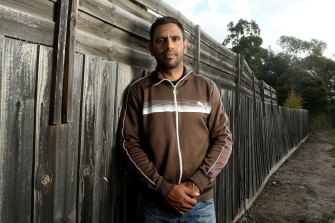Indigenous footy coverage again on the brink
Funding is again being sought to help prop up the AFL’s Indigenous radio service amid concerns black voices will be drowned out if the coverage cannot be saved.
The National Indigenous Radio Service, which says it has a reach of 700,000 people, has provided a pathway for Indigenous former players to enter the media, calling AFL matches since the 1990s.
Former Essendon player Nathan Lovett-MurrayCredit:Pat Scala
But the service’s football operation has been heavily reliant on funding from government, sponsors and the league, living a precarious existence in which it has several times been said to be on the brink of being discontinued.
That is again the case heading into 2021, with former Essendon player and now St Kilda development coach Nathan Lovett-Murray, a member of the NIRS commentary team, expressing his concerns about the coverage’s future on Sunday.
“[AFL NIRS head Andrew Underwood has] mentioned to all the broadcasters that they’re struggling to get some sponsorship at this stage and we’re looking for any support to keep it going,” Lovett-Murray said.
“I think there’s plenty of money out there, plenty of sponsors that would want to get on board and support Indigenous broadcasting, so it’s just a matter of getting the story out there.”
Sources familiar with the situation indicated that some of the coverage’s sponsorship deals had been imperilled by COVID-19, placing a greater financial strain on the broadcast than usual. Terms of a deal with the AFL this year are also yet to be finalised.
Former Indigenous players Chris Johnson, Darryl White, Gilbert McAdam and Tony Armstrong are among those whose media careers have been built with the experience of their time with the NIRS football coverage.
“I’ve been [a part of the regular commentary team] a fair bit for the last five years,” Lovett-Murray said.
“It’s definitely important for our community to be able to hear the games but also hear them from Indigenous broadcasters. That’s probably the most important part. It’s giving that pathway to Indigenous broadcasters, past players that are trying to get into media. This is a great stepping stone to get to that next level. That’s also really important. And just for the general audience that we have, being able to listen to those black voices, it’s something that we’ve got to keep going.
“I’ve been working with Andrew, trying to hit up different organisations and support the organisation.”
Most Viewed in Sport
Source: Read Full Article

